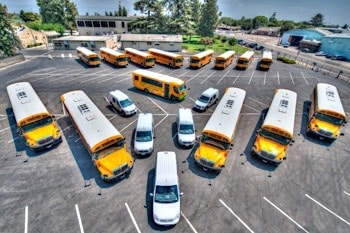“Our theme this year is mobilizing for impact. So how do we think about what partners should be working together to solve which problems?” Chelsea Clinton said about the Clinton Global Initiative’s (CGI) conference on the Sept. 19 broadcast of “The Daily Show.” The focus of the annual meeting in New York City, which opened yesterday, extends into the initiative’s working groups and programs such as the Electric School Bus Project.
Kevin Matthews of National Strategies LLC (NSI) said that CGI America approached him about a partnership because NSI is considered the leading public policy firm on vehicle-to-grid (V2G) projects. The plan is to use more electric school buses for student transportation and, in the off hours, plug them into a power grid to help grid operators maintain and regulate its operation.
Matthews said the working group is still in the solicitation phase, which involves partner identification, recruitment and fundraising. They have turned in several grant applications and will begin hearing back in October. These grants will assist school districts and school bus contractors in obtaining electric school buses, he explained. Talks with school transportation directors have centered on feasibility and cost.
“Some people thought V2G was just a theory, but there are already demonstration projects going in the state of Delaware, which shows it can happen and people can get paid for plugging in their car when they’re not using it,” Matthews said, emphasizing that student transporters could also generate revenue this way. “When you combine this with a school bus fleet, which has very specific operating parameters, you can aggregate the number of buses together, and considering they have large battery packs, the light bulbs go off and people understand.”
The plan is to launch two demonstration projects that would operate four electric buses each. While the partners haven’t chosen the two locations yet, Matthews shared that they are holding meetings in four states: California, North Carolina, Illinois and Massachusetts.
He added that it’s a very complicated project because many partners have to be brought on board, from state and regional entities, to city governments, to school districts. Their initial reaction has been “very supportive,” he noted, and the project is moving forward every day.
“It’s a three-year project, and the initial few months involved selecting partners, participants and raising funds since June. It will take a year to build the buses from that point in time,” Matthews continued. “In late 2014, we plan to begin putting buses into school-district use for a yearlong study period. When that is complete, we’ll collect and analyze all data and create a report, which will take four to six months.”
Once the report is out, Matthews said, companies such as Smith Electric, TransTech Bus, Thomas Built Buses, Blue Bird and others can review the data and determine the best way to build and market EV school buses to school districts and bus contractors.
The partners may also create another working group with the aim of retrofitting existing school buses to EV. Either way, CGI project goals remain the same, he stressed — improving children’s health, air quality and the overall environment, while also promoting electric vehicles and assisting smart grids.
“Those are the elements across the top that everybody has some interest in. The final element is reducing student transportation costs,” Matthews noted. “The perverse thing is that in some areas, diesel prices have gotten so high that school operating budgets have also risen, and they have stopped home-to-school transportation — which means you have more cars driving kids to school, creating more air pollution, traffic congestion and other negative impacts.”
In the demonstration projects, Matthews said that they don’t necessarily have to transport actual schoolchildren, but could use sandbags or buckets of water to simulate the children’s weight and collect the data they need.
It all began with a simple question posed during a working group discussion last year: If Frito-Lay can effectively deliver potato chips in a zero-emissions environment, why can’t we do that for our children on school buses?
Then someone recommended that Matthews’ group meet with CGI America, which had formed a Renewable and Distributed Energy working group.
“After that, Smith Electric, Ernst and Young, L.A. County and others began looking at this issue and figuring out the economics,” he recalled. “We had the V2G component that they were missing, and once we brought it all together, we created economic viability …
“If Frito-Lay can deliver potato chips, we should be able to figure this out for children.”














